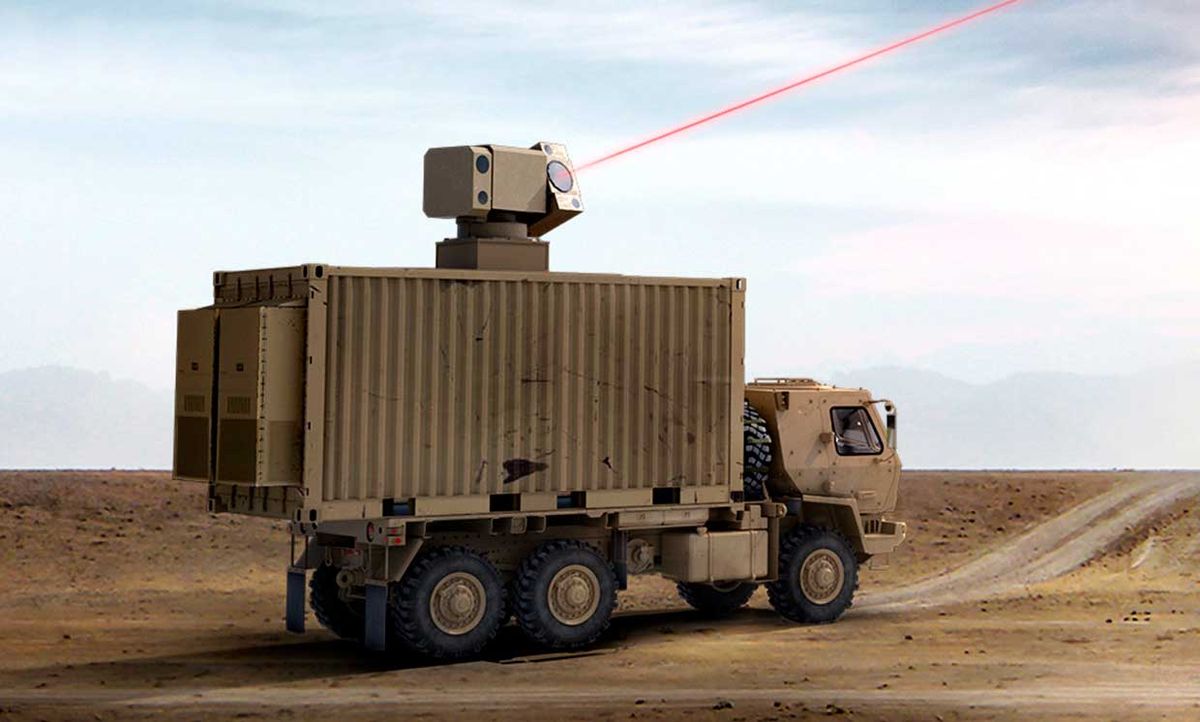Despite a lot of progress in recent years, practical laser weapons that can shoot down planes or missiles are still a ways off. But a new liquid laser may be bringing that day closer.
Much of the effort in recent years has focused on high-power fiber lasers. These lasers use specially doped coils of optical fibers to amplify a laser beam, and were originally developed for industrial cutting and welding. Initially, fiber laser were dark horses in the Pentagon's effort to develop electrically powered solid-state laser weapons that began two decades ago. However, by 2013 the Navy was testing a 30-kilowatt fiber laser on a ship. Since then, their ability to deliver high-energy beams of excellent optical quality has earned fiber lasers the leading role in the current field trials of laser weapons in the 50- to 100-kilowatt class. But now aerospace giant Boeing has teamed with General Atomics—a defense contractor also known for research in nuclear fusion—to challenge fiber lasers in achieving the 250-kilowatt threshold that some believe will be essential for future generations of laser weapons. Higher laser powers would be needed for nuclear missile defense.
The challenging technology was developed to control crucial issues with high energy solid-state lasers: size, weight and power, and the problem of dissipating waste heat that could disrupt laser operation and beam quality. General Atomics "had a couple of completely new ideas, including a liquid laser. They were considered completely crazy at the time, but DARPA funded us," said company vice president Mike Perry in a 2016 interview. Liquid lasers are similar to solid-state lasers, but they use a cooling liquid that flows through channels integrated into the solid-state laser material. A crucial trick was ensuring that the cooling liquid has a refractive index exactly the same as that of the solid laser material. A perfect match of the liquid and solid could avoid any refraction or reflection at the boundary between them. Avoiding reflection or refraction in the the cooling liquid also required making the fluid flow smoothly through the channels to prevent turbulence.
The system promised to be both compact and comparatively lightweight, just what DARPA wanted to fit a 150-kW laser into a fighter jet. The goal was a device that weighed only 750 kilograms, or just 5 kg/kW of output. The project that went through multiple development stages of testing that lasted a decade. In 2015, General Atomic delivered the HELLADS, the High Energy Liquid Laser Area Defense System, rated as 150-kW class, to the White Sands Missile Range in New Mexico for live fire tests against military targets. A press release issued at the time boasted the laser held "the world's record for the highest laser output power of any electrically powered laser." At the time, General Atomics described it as a modular laser weapon weighing in at four kilograms per kilowatt.

Development has continued since then. A spokesperson says General Atomics is now on the seventh generation of their "Distributed gain laser heads," modules which can be combined to generate over 250 kW of laser output from a very compact package. Improvements over the past two years have enhanced beam quality and the ability to emit high-energy beams both continuously or in a series of pulses, giving more flexibility in attacking targets.
Sustaining good beam quality at that power level is important. Mike Griffin, former undersecretary of defense for research and engineering, told Congress that current fiber laser technology could be scaled to 300 kilowatts to protect air force tankers. However, that may be pushing the upper limits of how many beams from separate fiber lasers emitting at closely spaced wavelengths can be combined coherently to generate a single high-energy laser beam of high quality.
The agreement calls for use General Atomics to supply integrated thermal management equipment and a high-density modular high-power lithium-ion battery system able to store three megajoules of energy as well as the laser. Boeing will supply a beam director and software for precision acquisition and pointing technology that Boeing developed and supplied for other experimental laser weapon testbeds, including the Air Force's megawatt-class Airborne Laser, the last big chemically-powered gas laser, scrapped in 2014. “Together, we’re leveraging six decades of directed energy experience and proven, deployed technologies," said Norm Tew, Boeing Missile and Weapon Systems vice president and general manager, and Huntsville site senior executive, in a statement.
Jeff Hecht writes about lasers, optics, fiber optics, electronics, and communications. Trained in engineering and a life senior member of IEEE, he enjoys figuring out how laser, optical, and electronic systems work and explaining their applications and challenges. At the moment, he’s exploring the challenges of integrating lidars, cameras, and other sensing systems with artificial intelligence in self-driving cars. He has chronicled the histories of laser weapons and fiber-optic communications and written tutorial books on lasers and fiber optics.



